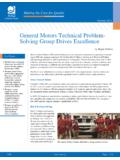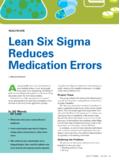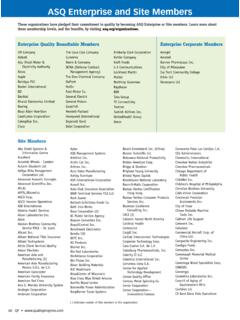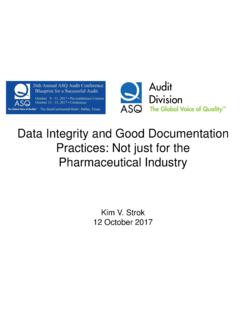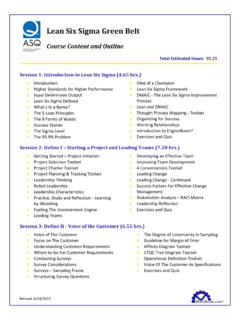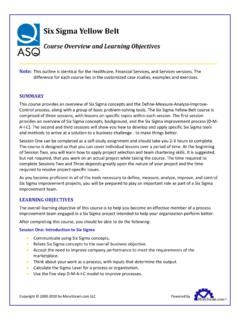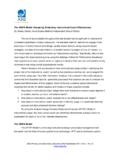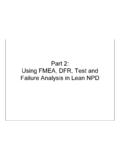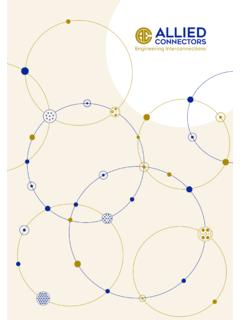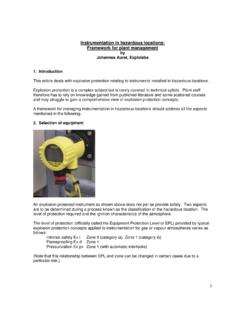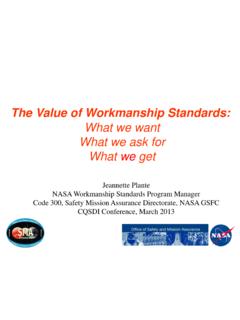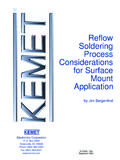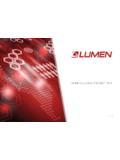Transcription of Manufacturing and Reliability Challenges With …
1 1 Manufacturing and Reliability Challenges with QFN (Quad Flat No Leads) ASQ Reliability Society Webinar March 10, 2011 Cheryl Tulkoff 2 Instructor Biography oCheryl Tulkoff has over 17 years of experience in electronics Manufacturing with an emphasis on failure analysis and Reliability . She has worked throughout the electronics Manufacturing life cycle beginning with semiconductor fabrication processes, into printed circuit board fabrication and assembly, through functional and Reliability testing, and culminating in the analysis and evaluation of field returns. She has also managed no clean and RoHS-compliant conversion programs and has developed and managed comprehensive Reliability programs. oCheryl earned her Bachelor of Mechanical Engineering degree from Georgia Tech. She is a published author, experienced public speaker and trainer and a Senior member of both ASQ and IEEE.
2 She holds leadership positions in the IEEE Central Texas Chapter, IEEE WIE (Women In Engineering), and IEEE ASTR (Accelerated Stress Testing and Reliability ) sections. She chaired the annual IEEE ASTR workshop for four years and is also an ASQ Certified Reliability Engineer. oShe has a strong passion for pre-college STEM (Science, Technology, Engineering, and Math) outreach and volunteers with several organizations that specialize in encouraging pre-college students to pursue careers in these fields. 3 DfR Solutions works with companies and individuals throughout the life cycle of a product, lending a guiding hand on quality , Reliability and durability (QRD) issues that allows your staff to focus on creativity and ideas. Our expertise in the emerging science of Electrical and Electronics Reliability Physics provides crucial insights and solutions early in product design, development and test throughout Manufacturing , and even into the field.
3 4 oWe use Physics-of-Failure (PoF) and best Practices expertise to provide knowledge- based strategic quality and Reliability solutions to the electronics industry oTechnology Insertion oDesign oManufacturing and Supplier Selection oProduct Validation and Accelerated Testing oRoot-Cause Failure Analysis & Forensics Engineering oUnique combination of expert consultants and state-of-the-art laboratory facilities Who is DfR Solutions? 5 DfR Clients Military / Avionics / Space oRockwell Collins oDRS oHoneywell oApplied Data Systems oMercury Computers oDigital Receiver Technology oHamilton Sundstrand oKato Engineering oThales Communications oL-3 Communications oInnovative Concepts oSandia National Labs oCrane (Eldec) oViaSat oEaton Automotive / Commercial Vehicle oGeneral Motors oCaterpillar oPanasonic Automotive oHella Automotive oLG Electronics oTyco Electronics oTRW oMicroHeat Medical oBiotronik oPhilips Medical oAbbott Laboratories oTecan Systems oNeuropace oInter-Metro oWelch Allyn oGuidant / Boston Scientific oBeckman Coulter oApplied Biosystems oCardinal Health oMedtronic oCardiac Science Server / Telecom oLucent Technologies oSun Microsystems oCisco Systems oArtesyn Communications oCorvis Communications oHuawei (China)
4 OAirgo Networks oVerigy oAntares ATT oEnterasys oTrue Position oHiFN oCedar Point oOptics1 oTropos Networks Consumer / Appliance oFujitsu (Japan) oDell Computers oSamsung (Korea) oLG Electronics (Korea) oTubitak Mam (Turkey) oInsinkerator oWhite Rodgers oEmerson Appliance Controls oTherm-O-Disc oNMB Technologies oShure oHandi-Quilt oXerox Portables oRSA Security oHandheld oKyocera oLG Electronics Contract Manufacturers oDaeduck (Korea) oGold Circuit Electronics (Taiwan) oEngent oEIT Industrial / Power Schlumberger Copeland Tennant Rosemount Branson Computer Process Controls ASCO Power ASCO Valve Astec Liebert Avansys Tyco Electronics Rainbird MicroMotion Siemens Barco Calex Western Geco (Norway) General Electric Ingersoll Rand Fusion UV Numatics Durotech Danaher Motion TallyGencom Vision Research Olympus NDT Components Fairchild Semiconductor Maxtek Samsung ElectroMechanics (Korea) Pulse Teradyne Amphenol AVX Anadigics Kemet NIC Graftech International Rectifier 6 oEpidemiological Study of SnAgCu Solder: Benchmarking Results from Accelerated Life Testing oWhat I Don t Know That I Don t Know.
5 Things to Worry About with the Pb-Free Transition oLong-term Reliability of Pb-free Electronics oRobustness of Ceramic Capacitors Assembled with Pb-Free Solder oFailure Mechanisms in LED and Laser Diodes oMicrostructure and Damage Evolution in Pb-Free Solder Joints oImproved Methodologies for Identifying Root-Cause of Printed Board Failures oReliability of Pressure Sensitive Adhesive Tapes for Heat Sink Attachment oFailure Mechanisms in Electronic Products at High Altitudes oDetermining the Lifetime of Conductive Adhesive / Solder Plated Interconnections oIssues in Long-Term Storage of Plastic Encapsulated Microcircuits oEffect of PWB Plating on the Microstructure and Reliability of SnAgCu Solder Joints oA Demonstration of Virtual Qualification for the Design of Electronic Hardware oSolder Failure Mechanisms in Single-Sided Insertion-Mount Printed Wiring Boards oFinite Element Modeling of Printed Circuit Boards for Structural Analysis Selected Publications 7 DfR Resources and Equipment Electrical oOscilloscopes oDigital oAnalog oCurve Tracers oDigital oAnalog oPartial Discharge Detector oCapacitance Meters oLow Resistance Meters oHigh Resistance Meters oHigh Voltage Power Supplies (Hi-Pot) Testing oHALT oTemperature Cycling oThermal Shock oTemperature/Humidity oVibration oMechanical Shock / Drop Tower oMixed Flowing Gas oSalt Spray oCapacitor Testing (Ripple Current)
6 Material Analysis oX-ray oAcoustic Microscopy oInfrared Camera oMetallographic Preparation oStereoscope oOptical Microscope oScanning Electron Microscope oEnergy Dispersive Spectroscopy oIon Chromatography oFTIR (Solid / Film / Liquid) oThermomechanical Analyzer oSQUID Microscopy oXray Diffraction oFocused Ion Beam Imaging oXPS Other oCircuit Simulation oFinite Element Analysis (FEA) oComputational Fluid Dynamics oReliability Prediction (Physics of Failure) 8 8 Knowledge and Education (Website) oLet your staff learn all day / every day E-LEARNING oScholarly articles oTechnical white papers oCase studies oReliability calculators oOnline presentations 9 9 QFN as a Next Generation Technology oWhat is Next Generation Technology? oMaterials or designs currently being used, but not widely adopted (especially among hi-rel manufacturers) oCarbon nanotubes are not Next Generation oNot used in electronic applications oBall grid array is not Next Generation oWidely adopted 10 10 Introduction (cont.)
7 OWhy is knowing about Next Generation Technologies important? oThese are the technologies that you or your supply chain will use to improve your product oCheaper, Faster, Stronger, Environmentally-Friendly , etc. oAnd sooner then you think! 11 11 Reliability and Next Generation Technologies oOne of the most common drivers for failure is inappropriate adoption of new technologies oThe path from consumer (high volume, short lifetime) to high rel is not always clear oObtaining relevant information can be difficult oInformation is often segmented oFocus on opportunity, not risks oCan be especially true for component packaging oBGA (Ball Grid Array), flip chip, QFN (Quad Flat No Lead) 12 12 Component Packaging oMost of us have little influence over component packaging oMost devices offer only one or two packaging styles oWhy should you care?
8 OPoor understanding of component qualification procedures oWho tests what and why? 13 13 Component Testing oReliability testing performed by component manufacturers is driven by JEDEC oJESD22 series (A & B) oFocus is almost entirely on die, packaging, and 1st level interconnections (wire bond, solder bump, etc.) oOnly focus on 2nd level interconnects (solder joints) is JESD22-B113 Cyclic Bend Test oDriven by cell phone industry oThey have little interest in thermal cycling or vibration! 14 14 2nd Level Interconnect Reliability oIPC has attempted to rectify this through IPC-9701 oTwo problems oAdopted by OEMs; not by component manufacturers oApplication specific; you have to tell them the application (your responsibility, not theirs) oThe result oAn increasing incidence of solder wearout in next generation component packaging 15 15 Solder Wearout in Next Generation Packaging Performance Needs oHigher frequencies and data transfer rates oLower resistance-capacitance (RC) constants oHigher densities oMore inside less plastic oLower voltage, but higher current oJoule heating is I2R oHas resulted in less robust package designs 16 16 Solder Wearout (cont.)
9 OElimination of leaded devices oProvides lower resistance-capacitance (RC) and higher package densities oReduces compliance Cycles to failure -40 to 125C QFP: >10,000 BGA: 3,000 to 8,000 QFN: 1,000 to 3,000 CSP / Flip Chip: <1,000 17 17 Solder Wearout (cont.) oDesign change: More silicon, less plastic oIncreases mismatch in coefficient of thermal expansion (CTE) BOARD LEVEL ASSEMBLY AND Reliability CONSIDERATIONS FOR QFN TYPE PACKAGES, Ahmer Syed and WonJoon Kang, Amkor Technology. 18 18 Solder Wearout (cont.) oHotter devices oIncreases change in temperature (DT) 0100020003000400050006000700080009000100 00050100150200 Change in Temperature (oC)Characteristic Life (Cycles to Failure)tf = DTn n = 2 (SnPb) n = (SnNiCu) n = (SnAgCu) 19 19 Industry Response to SJ Wearout? oJEDEC oSpecification body for component manufacturers oJEDEC JESD47 oGuidelines for new component qualification oRequires 2300 cycles of 0 to 100C oTesting is often done on thin boards oIPC oSpecification body for electronic OEMs oIPC 9701 oRecommends 6000 cycles of 0 to 100C oTest boards should be similar thickness as actual design 20 20 BIG PROBLEM oJEDEC requirements are 60% less than IPC oTesting on a thin board can extend lifetimes by 2X to 4X oWhat does this mean?
10 OThe components you buy may only survive 500 cycles of 0 to 100C oWhat must you do? oComponents at risk must be subjected to PoF-based (Physics of Failure) Reliability analysis 21 21 Quad Flat Pack No Leads or Quad Flat No Leads (QFN) 22 22 QFN: What is it? oQuad Flat Pack No Lead or Quad Flat Non-Leaded o The poor man s ball grid array oAlso known as oLeadframe Chip Scale Package (LF-CSP) oMicroLeadFrame (MLF) oOthers (MLP, LPCC, QLP, HVQFN, etc.) oOvermolded leadframe with bond pads exposed on the bottom and arranged along the periphery of the package oDeveloped in the early to mid-1990 s by Motorola, Toshiba, Amkor, etc. oStandardized by JEDEC/EIAJ in late-1990 s oFastest growing package type 23 23 QFN Advantages: Size and Cost oSmaller, lighter and thinner than comparable leaded packages oAllows for greater functionality per volume oReduces cost oComponent manufacturers: More ICs per frame oOEMs: Reduced board size oAttempts to limit the footprint of lower I/O devices have previously been stymied for cost reasons oBGA materials and process too expensive 24 24 Advantages: Manufacturability oSmall package without placement and solder printing constraints of fine pitch leaded devices oNo special handling/trays to avoid bent or non planar pins oEasier to place correctly on PCB pads than fine pitch QFPs, TSOPs, etc.
